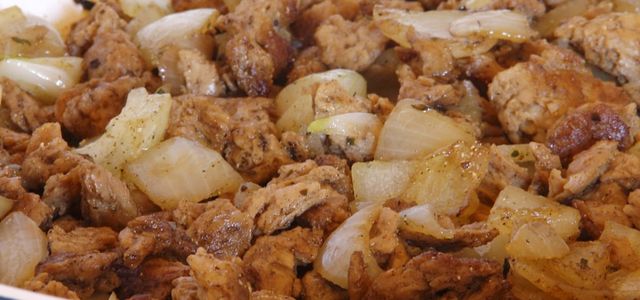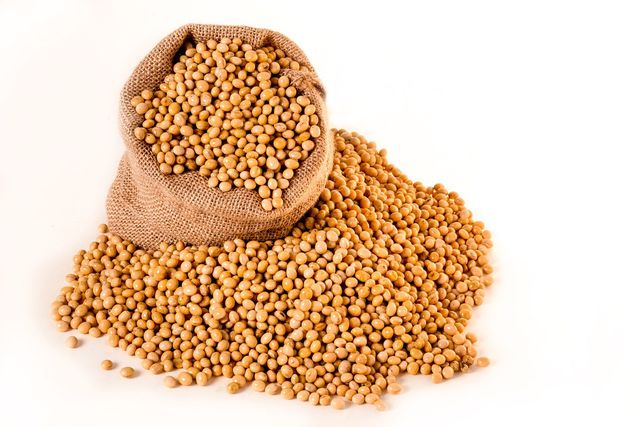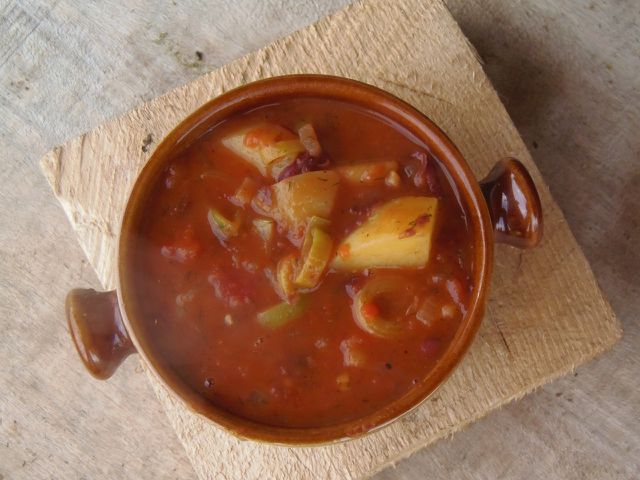Soybean sliced: nutritional values, use, and recipes

Soybean noodles are a popular meat substitute that does not require any additives. Here you can find out how the soy meat is made, how healthy it is, and how you can prepare it.
Soybean slicer: production and nutritional values
Soybeans are a popular vegan meat alternative that is made from 100 percent soybeans. It can also be found under the name "soy meat". For the production, the soybeans must first be peeled and ground. Then the majority of the fat is pressed out of the soy flour. Finally, the defatted flour is shaped into soybeans.
This process ensures that soybeans are a relatively low-fat product. Alnatura's soybeans have only six grams of fat per 100 grams.
Since soybeans contain a lot of vegetable protein, soybean cutlet is also a good source of protein: 100 grams provide you with 52 grams of protein.
With 16 grams of fiber per 100 grams, they are also filling food.
The proportion of carbohydrates is around 15 percent.
In total, 100 grams of Alnatura soybean noodle provide you with 354 calories.
Soybeans are also rich in various micronutrients: they contain several B vitamins, as well as considerable amounts of calcium, magnesium, iron, zinc, and potassium.
When buying soybeans, you should pay attention to organic goods. This way you guarantee that no genetic engineering or synthetic pesticides are used in the production. Also, use regional produce if possible: You also get soy products from German cultivation.
Use of soybeans and basic recipe

Soybean noodles do not contain any additives, are long-lasting, and easy to prepare.
Soybean noodles do not contain any additives, are long-lasting, and easy to prepare.
Soybean noodles are usually available in two forms: the rough variant is particularly suitable as a meat alternative for vegan goulash or as a vegan chicken alternative in salads or vegetable pans. The fine soy schnitzel is reminiscent of minced meat and is therefore used in vegan Bolognese sauces, chili sin carne, as an ingredient for vegan burgers or as a filling for baked peppers.
For all recipes, you have to prepare the soybean cutlet. To do this, you can follow the instructions on the packaging or follow the steps below:
Put the dry soy schnitzel in a saucepan with a little vegetable stock: for the coarse schnitzel, take three times the amount of liquid. You can use approximately the same amount of broth for the fine variant.
Boil the broth once briefly and then let the schnitzel soak in the hot liquid for about ten minutes.
You should now swell well and be completely infused with liquid.
Pour the remaining broth off. You don't have to throw them away, you can reuse them as an ingredient in soups or sauces.
Squeeze out the coarse soybeans with a spoon so that some more liquid escapes. Otherwise, it quickly happens that they become too mushy.
Fry the soybeans in a pan with a little oil or use them according to your recipe.
Recipe with soybeans: Asian vegetable noodle pan

With the right marinade, the soybean cutlet becomes an aromatic ingredient for Asian dishes.
With the right marinade, the soybean cutlet becomes an aromatic ingredient for Asian dishes.
For four servings you need:
150 g of fine soybeans
3 tbsp peanut or sesame oil
150ml soy sauce
20g ginger
2 cloves of garlic
Chilli flakes (optional)
2tbsp tomato paste
1 tsp raw cane or whole cane sugar
1/2 tbsp rice vinegar
100g spring onions
600g vegetables as desired (for example carrots, beans, broccoli, bell pepper, zucchini, eggplant)
250g Mie noodles
That's how it's done:
Prepare the soybeans according to the basic recipe.
Grate the ginger finely and press the garlic through a garlic press.
Chop the spring onions.
Mix ginger, garlic, two tablespoons of oil, soy sauce, possibly chili flakes, tomato paste, sugar, and vinegar into a marinade.
Add onions and soybean cutlets and let the mixture steep for at least an hour.
Prepare the vegetables. It should be cooked but still firm to the bite. It's best to use a steamer for this. You can also briefly there but blanch.
Heat a tablespoon of oil in a pan and sauté the cooked vegetables with the marinated soybeans for about ten minutes.
Cook the Mie noodles according to the package instructions and serve them together with the soy-vegetable pan.
Goulash with soybeans and potatoes

Coarse soybeans are particularly suitable for a hearty goulash.
Coarse soybeans are particularly suitable for a hearty goulash.
For four to six servings you need:
125 g of coarse soybeans
4-5 tablespoons of rapeseed oil
salt and pepper
garlic
Paprika powder (smoked)
1.2 kg potatoes (firm cooking)
2 red peppers
2-3 medium onions
3 tbsp tomato paste
500 g sauerkraut
800 ml of passed tomatoes
200 ml vegetable broth
1 tsp sugar
½ tsp caraway powder
1 tsp paprika powder (sweet)
2 bay leaves
optional: about 100 g soy or oat cream
How to prepare the goulash with soybeans:
Prepare the coarse soybeans according to the basic recipe. Then fry them well in a little rapeseed oil until they are light brown and crispy.
Season them in the pan with salt and pepper and add a little garlic and (smoked) paprika powder to taste. Take the schnitzel out of the pan and set them aside.
Peel the potatoes and cut them into cubes.
Wash the peppers, remove the inside, and also cut them into cubes.
Peel the onion and cut it into rings or cubes.
Put some rapeseed oil in a large saucepan and sauté the onions for about five minutes. Add pieces of bell pepper, potatoes, and tomato paste and steam for about seven to ten minutes.
Add the sauerkraut and fill up the mixture with strained tomatoes and vegetable stock.
Add sugar, cumin, paprika powder, and bay leaves and season the goulash with salt and pepper.
Let the goulash stew for about 30 minutes.
Then remove the bay leaves and stir in the soybeans.
Refine the goulash as you like with a little soy or oat cream.

0 Comments